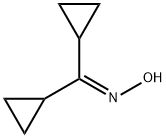Dicyclopropyl ketone
Synonym(s):Dicyclopropylketone
- CAS NO.:1121-37-5
- Empirical Formula: C7H10O
- Molecular Weight: 110.15
- MDL number: MFCD00001276
- EINECS: 214-331-5
- SAFETY DATA SHEET (SDS)
- Update Date: 2025-09-25 17:15:13

What is Dicyclopropyl ketone?
Chemical properties
clear colourless to yellowish liquid
The Uses of Dicyclopropyl ketone
Dicyclopropyl Ketone is used as a reagent in the synthesis of a new class of potent and selective agonists of dimeric carbamoylguanidine-type histamine H2 receptor ligands. Also used in the preparation of chemical space analogs of PNU-282,987 and SSR180711, which have nicotinic receptor activity.
Preparation
Preparation of Dicyclopropyl ketone
Reaction: To a one liter three-necked flask fitted with a reflux condenser and a metal Hershberg stirrer there was added 600 ml. of 20% sodium hydroxide and 165g . (0.9mole) of 1,7 -dichloro-4-heptanone. The mixture was refluxed for 30 minutes with vigorous stirring, then steam distilled until the characteristic odor of dicyclopropyl ketone was absent from the distillate. The distillate was then saturated with potassium carbonate, the upper layer separated and the water layer extracted once with ether. The combined organic layers were dried over potassium carbonate. after removal of the ether there was dist illed 69g. (70%) of dicyclopropyl ketone, b.p . 69° at 20 mm, nD25 1.4648-1.4654.
Properties of Dicyclopropyl ketone
| Melting point: | 44.0-44.5 °C |
| Boiling point: | 160-162 °C(lit.) |
| Density | 0.977 g/mL at 25 °C(lit.) |
| refractive index | n |
| Flash point: | 103 °F |
| storage temp. | Store below +30°C. |
| Specific Gravity | 0.957 |
| Water Solubility | Soluble in water. |
| BRN | 774172 |
| CAS DataBase Reference | 1121-37-5(CAS DataBase Reference) |
| NIST Chemistry Reference | Methanone, dicyclopropyl-(1121-37-5) |
Safety information for Dicyclopropyl ketone
| Signal word | Warning |
| Pictogram(s) |
 Flame Flammables GHS02 |
| GHS Hazard Statements |
H226:Flammable liquids |
| Precautionary Statement Codes |
P210:Keep away from heat/sparks/open flames/hot surfaces. — No smoking. P233:Keep container tightly closed. P240:Ground/bond container and receiving equipment. P241:Use explosion-proof electrical/ventilating/lighting/…/equipment. P242:Use only non-sparking tools. P243:Take precautionary measures against static discharge. |
Computed Descriptors for Dicyclopropyl ketone
New Products
Indole Methyl Resin tert-butyl 9-methoxy-3-azaspiro[5.5]undecane-3-carboxylate Boc-His(Boc)-OH 2-CTC Resin 4-Chloro-7-tosy1-7Hpyrrolo[2,3-d]pyrimidine 5,7-Dibromo-1H-indole 2,5-dichloro-N-hydroxy-4,6-dimethylpyridine-3-carboximidamide 2,2-Dimethoxy-7-azaspiro[3.5]nonane hydrochloride 4-chloromethyl-5-methyl-1,3-dioxol-2-one (DMDO-Cl) R-2-BENZYLOXY PROPIONIC ACID 1,1’-CARBONYLDIIMIDAZOLE 1,1’-CARBONYLDI (1,2-4 TRIAZOLE) N-METHYL INDAZOLE-3-CARBOXYLIC ACID 4-((2-hydroxyethyl)thio)benzoic acid 1-(TERT-BUTOXYCARBONYL)-2-PYRROLIDINONE Methyl 6-methylnicotinate 3-Pyridineacrylic acid tert-Butyl carbazate TETRAHYDRO-2H-PYRAN-3-OL 2-((4-morpholinophenylamino) (methylthio) methylene) malononitrile 3-(4-morpholinophenylamino)-5-amino-1H-pyrazole-4-carbonitrile 2,4-dihydroxybenzaldehyde 1,3-Diethyl-1,3-Diphenylurea Methyl 2-methylquinoline-6-carboxylateRelated products of tetrahydrofuran



![9-BENZYL-1,6-DIPHENYL-9-AZADISPIRO[2.1.2.3]DECAN-4-ONE](https://img.chemicalbook.in/StructureFile/ChemBookStructure5/GIF/CB4376154.gif)




You may like
-
 Dicyclopropylketone, 95% CAS 1121-37-5View Details
Dicyclopropylketone, 95% CAS 1121-37-5View Details
1121-37-5 -
 Dicyclopropyl Ketone CAS 1121-37-5View Details
Dicyclopropyl Ketone CAS 1121-37-5View Details
1121-37-5 -
 Dicyclopropylketone CAS 1121-37-5View Details
Dicyclopropylketone CAS 1121-37-5View Details
1121-37-5 -
 Pyridine 99.5% HPLC /UV SpectroscopyView Details
Pyridine 99.5% HPLC /UV SpectroscopyView Details
110-86-1 -
 Piperazine Spot supply, best priceView Details
Piperazine Spot supply, best priceView Details
110-85-0 -
 Dibutyl PhthalateView Details
Dibutyl PhthalateView Details
84-74-2 -
 Imidazole Spot supply, competitive priceView Details
Imidazole Spot supply, competitive priceView Details
288-32-4 -
 Thiourea 99% ARView Details
Thiourea 99% ARView Details
62-56-6
